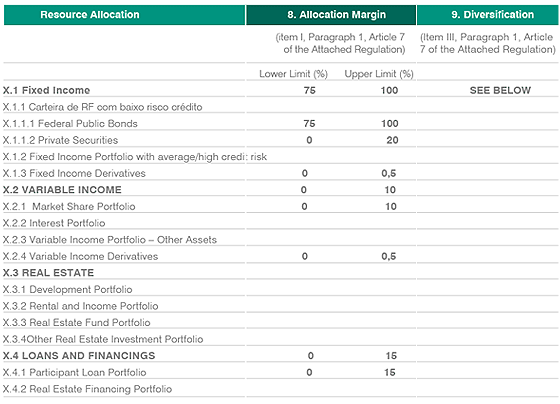PREVI FUTURO
Investment Policy Benefit Plan 1 PREVI Futuro Capec
1. Closed Entity of Complementary Social Security:
Caixa de Previdência dos Funcionários do Banco do Brasil - PREVI
2. Fiscal Year:
2007
3. Minutes of the Deliberative Council / Meeting Date:
Minutes 203, Decision No. 2006/164 of 14/DEC/2006
4. Benefit Plan:
PREVI Futuro Benefit Plan
5. Actuarial Target of the Benefit Plan:
INPC + 6%, in relation to the Provisions of Part I and to the Mathematical Provision of Granted Benefits of Part II
6. AETQ - Technically Qualified Statutory Administrator:
6.1. Fixed Income: Cecília Garcez and José Reinaldo Magalhães
6.2. Variable Income: Cecília Garcez and José Reinaldo Magalhães
6.3. Real Estates: Cecília Garcez and José Reinaldo Magalhães
6.4. Financing: Cecília Garcez and José Ricardo Sasseron
7. Mechanism to Inform the Participants about the Policy
(X) Electronic Means
(X) Printout
8. Chart Summarizing the EFPC Investment Policy, pursuant to the Regulation attached to CMN Resolution No. 3.121/2003

Obs: Allocation Margin proposed for 2007
(* The investment in operations with derivatives is exclusively foreseen when performed within the scope of the PIBB investment fund.
9. Diversification(Item III, § 1, Article 7 of the Attached Regulation)
Fixed Income
a) Observe the limits established in article 17, items I to III, of CMN Resolution No. 3121/2003.
b) In the specific case of investments in securities issued by and/or under co-obligation with a financial institution or another institution authorized to operate by Banco Central do Brasil (Brazilian Central Bank), in repurchase operations and in savings deposits, also observe the following limits:
15% of the net worth of the issuer, in the case of institutions considered as low credit risk entities - risk class A, in compliance with PREVI methodology.
12% of the net worth of the issuer, in the case of institutions considered as average credit risk entities - risk class B, in compliance with PREVI methodology.
10% of the net worth of the issuer, in the case of institutions considered as average credit risk entities - risk class C, in compliance with PREVI methodology
Variable Incomea) Observe the limits established in articles 26 and 27 of CMN Resolution No. 3121/2003.
General Diversification Limits
a) Observe the limits established in articles 48, 49, 50 and 52 of CMN Resolution No. 3121/2003.
10. Management Purposes
(Item II, § 1, Article 7 of the Attached Regulation)
The main purpose of the Investment Policy is to ensure availability of resources for the accomplishment of PREVI mission, namely:
Administer Benefit Plans, with effective management of the resources provided, seeking better solutions to ensure the social security benefits, so as to contribute for the quality of life of the participants and their dependents, aiming to meet their expectations as well as those of the sponsors.
The Investment Policy for PREVI Futuro Plan also aims to ensure attractiveness towards the Plano, to the extent that it optimizes the management of the investments and make the information transparent.
PREVI Futuro Plan was created to attend to the needs of the Banco do Brasil employees hired after 24/DEC/1997.
PREVI Futuro Plan is a mixed Benefit Plan. In the accumulation period it has characteristics of Definite Contribution for programmed benefits and of Definite Benefit for risk benefits. In the benefit payment period it has characteristics of Definite Benefit, taking into account that, after the value of the first benefit is defined, it begins to be readjusted by the actuarial index.
According to its Regulation, the PREVI Futuro Plan reserves are segregated by parts, since they have specific purposes. The joint "Part I" is related to the risk benefits, which are understood as: complement of retirement for disability and complement of pension for death. In this case, the management of the investments aims to seek assets that offer profitability in compliance with the actuarial goal (INPC + 6%).
On the other hand, "Part II", not joint, is destined to the formation of savings reserves by the participants to finance the programmed benefits. For these resources, the manager must always seek the optimization of the profitability of the investments in Fixed Income and Variable Income, following the best return/risk ratio.
In brief, the Investment Policy aims to achieve the following goals:
Optimization of the profitability, following the best return/risk ratio
Diversification of the investments
Transparence in the information
Investment of the resources according to the targets of each part of the Plan
11. Engagement Criteria - Management of Fixed Income and Variable Income Portfolios(Item V, § 1, Article 7 of the Attached Regulation)
The criteria for engagement of external managers for the administration of the portfolios of investments in Variable Income are classified as:
a) Qualitative - General data concerning the asset managing company:
Names and brief résumés of shareholders, administrators and analysis team
Customer portfolio
Company experience
PREVI experience with the company
b) Quantitative - Financial data concerning the assets administered by the company:
Total administered assets per type
Administered assets of institutional investors
Administered assets per investment (portfolios and volume)
Profitability of the investments
Considering the specific characteristics of each case, the various elements shall be taken into account so as to identify the manager with the best profile for the administration of the resources. In every engagement, after the survey and consolidation of the data, the process shall be submitted to the Executive Board for deliberation.
12. Person in Charge, Place and DateCecília Garcez
Planning Division
Rio de Janeiro, 14 December 2006